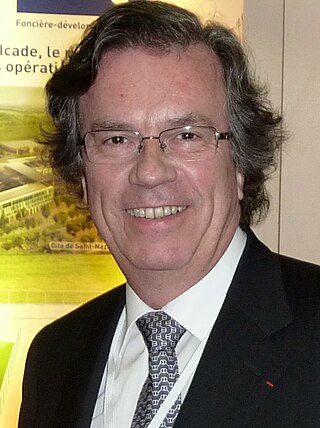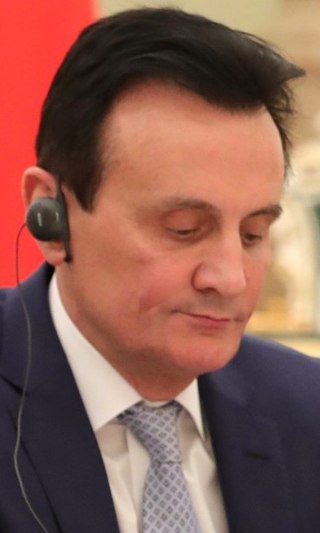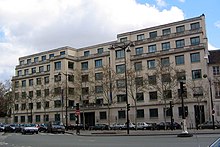
Mifepristone, also known as RU-486, is a medication typically used in combination with misoprostol to bring about a medical abortion during pregnancy and manage early miscarriage. This combination is 97% effective during the first 63 days of pregnancy. It is also effective in the second trimester of pregnancy. It is taken by mouth.

Hoechst AG was a German chemicals then life-sciences company that became Aventis Deutschland after its merger with France's Rhône-Poulenc S.A. in 1999. With the new company's 2004 merger with Sanofi-Synthélabo, it became a subsidiary of the resulting Sanofi-Aventis pharmaceuticals group.

Telithromycin is the first ketolide antibiotic to enter clinical use and is sold under the brand name of Ketek. It is used to treat community acquired pneumonia of mild to moderate severity. After significant safety concerns, the US Food and Drug Administration sharply curtailed the approved uses of the drug in early 2007.

King Pharmaceuticals, is a pharmaceutical company, a wholly owned subsidiary of Pfizer based in Bristol, Tennessee. Before being acquired by Pfizer, it was the world's 39th largest pharmaceutical company. On October 12, 2010, King was acquired by Pfizer for $14.25 per share. King produced a wide range of pharmaceuticals, including Altace for heart attack prevention, Levoxyl for hypothyroidism, Sonata, a sleeping aid, and Skelaxin, a muscle relaxant. King Pharmaceuticals operated manufacturing facilities in Bristol, Tennessee; Rochester, Michigan; St. Louis, Missouri; St. Petersburg, Florida; and Middleton, Wisconsin. They employed approximately 2,700 people including a sales force of over 1,000 individuals.
Rhône-Poulenc was a French chemical and pharmaceutical company founded in 1928. In 1999 it merged with Hoechst AG to form Aventis. As of 2015, the pharmaceutical operations of Rhône-Poulenc are part of Sanofi and the chemicals divisions are part of Solvay group and Bayer Crop Science.
John M. Gregory is a former CEO of King Pharmaceuticals, Inc. and resides in Bristol, Tennessee. In addition to founding King Pharmaceuticals in 1993, Gregory has founded several other notable business ventures including SJ Strategic Investments and Leitner Pharmaceuticals. Gregory has also made major investment outside of the pharmaceutical industry, such as his investments within the privately held United Coal Company located in southwest Virginia and Adams Golf with U.S. corporate offices in Texas. Most recently, Gregory, along with other family members, began Gregory Pharmaceutical Holdings Inc. which include pharmaceutical contract manufacturing company, UPM Pharmaceuticals, and NFI Consumer Products which includes the Blue-Emu brand of products.

Claude Évin is a French politician and lawyer.

Prenylamine (Segontin) is a calcium channel blocker of the amphetamine chemical class that was used as a vasodilator in the treatment of angina pectoris.
Marion Merrell Dow and its predecessor Marion Laboratories was a U.S. pharmaceutical company based in Kansas City, Missouri, from 1950 until 1996.

Cassella AG, formerly Leopold Cassella & Co. and Cassella Farbwerke Mainkur AG, commonly known as Cassella, was a German chemical and pharmaceutical company with headquarters in Frankfurt am Main. Founded in 1798, in the Frankfurt Jewish Alley by Leopold Cassella, Cassella operated as an independent company until 1995, and was one of many predecessor companies of today's Sanofi. Its main products were dyes, drugs, cosmetics and various other chemical products. From 1949, Cassella focused increasingly on pharmaceuticals and cosmetics rather than its former primary focus, dyes. Much of its history is closely associated with the Gans family, a prominent family of industrialists and philanthropists and former owners of Cassella.
Hoechst Schering AgrEvo GmbH was a Düsseldorf-based limited liability company owned by Hoechst AG and Schering AG that only existed as an independent company for five years, from 1994 to 1999.

Besipirdine, an indole-substituted analog of 4-aminopyridine, is a nootropic drug developed for the treatment of Alzheimer's disease (AD).

Sir Pascal Claude Roland Soriot is a French-born Australian businessman and chief executive officer (CEO) of the British-Swedish multinational pharmaceutical and biotechnology company AstraZeneca.
Corcept Therapeutics Inc. is a pharmaceutical company engaged in the discovery, development and commercialization of drugs for the treatment of severe metabolic, psychiatric and oncologic disorders. Corcept has focused on the adverse effects of excess cortisol, studying new compounds that may mitigate those effects. Its executive team is headed by CEO, president and director Joseph K. Belanoff, MD, and by chief medical officer Robert S. Fishman, MD.
A medical abortion, also known as medication abortion, occurs when drugs (medication) are used to bring about an abortion. Medical abortions are an alternative to surgical abortions such as vacuum aspiration or dilation and curettage. Medical abortions are more common than surgical abortions in most places, including Europe, India, China, and the United States.

RU-58841, also known as PSK-3841 or HMR-3841, is a nonsteroidal antiandrogen (NSAA) which was initially developed in the 1980s by Roussel Uclaf, the French pharmaceutical company from which it received its name. It was formerly under investigation by ProStrakan for potential use as a topical treatment for androgen-dependent conditions including acne, pattern hair loss, and excessive hair growth. The compound is similar in structure to the NSAA RU-58642 but contains a different side-chain. These compounds are similar in chemical structure to nilutamide, which is related to flutamide, bicalutamide, and enzalutamide, all of which are NSAAs similarly. RU-58841 can be synthesized either by building the hydantoin moiety or by aryl coupling to 5,5-dimethylhydantoin.

Toripristone (INN) is a synthetic, steroidal antiglucocorticoid as well as antiprogestogen which was never marketed. It is reported as a potent and highly selective antagonist of the glucocorticoid receptor (GR), though it also acts as an antagonist of the progesterone receptor (PR). The pharmacological profile of toripristone is said to be very similar to that of mifepristone, except that toripristone does not bind to orosomucoid. The drug has been used to study the hypothalamic-pituitary-adrenal axis and has been used as a radiotracer for the GR. Its INN was given in 1990.











